
The bones of children are extremely malleable. Kids can have their palates expanded, jaws realigned, and facial bone structure changed. Doctors Mike and John Mew do exactly this at their Orthotropics clinic in London. However, adults can get mewing results as well.
Mewing works for adults, though it is most effective in children. Plenty of people over the age of 18 have expanded their palates, improved their facial structure, and gained increased health as a result. Bone remodeling is a lifetime process.
Bone Remodeling
The problem is that too many people think of bones as they exist outside the body, as hardened fossils. Instead, it’s better to think of them as living organisms. They have nerves, a blood supply, and constantly generate new cells such as red blood cells, platelets, and white blood cells. Nutrients move in and out of the bone via marrow sinusoids and blood vessels. This is why bones tend to be porous.
Here’s what a bone looks like under the microscope:
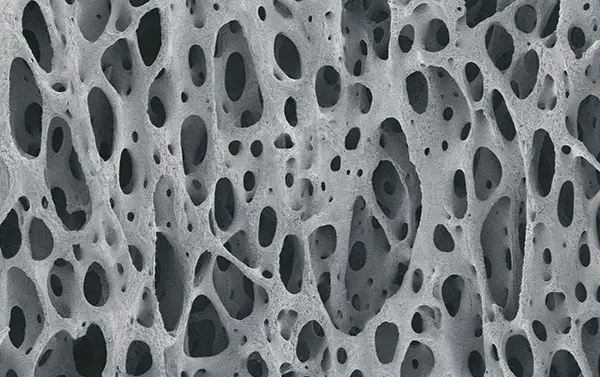
Bones remodel throughout an entire lifetime. In babies, 100% of the bone gets remodeled every year. In adults, this number drops to 10%, but this is still significant enough to effect change in response to a stimulus.
Large cells called osteoclasts come in to break down the bone. Cells called osteoblasts then come in and lay down new bone. This is constantly happening.
Sutural Growth
The skull has several sutures where bones fit together:
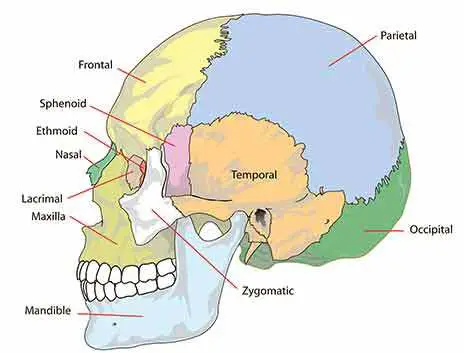
From all birth until adolescence, these suture sites are places of new bone growth. Because bone has a good blood supply and heals rapidly, more bone grows at these suture sites where the bone is thinner. However, after adulthood is reached, the suture sites start to ossify and close up. With proper mewing and posture, the pieces of the skull rotate into their proper configuration like pieces of a puzzle. One such suture is the midpalatal suture, which essentially splits the skull in half and contributes to a wide palate when the proper stress is placed upon it during adolescence.
Emphasis is often placed on sutural growth and splitting the midpalatal suture because then the rate of bone growth can be massively sped up, as the bone starts to want to heal itself (a fast process) instead of remodeling itself (a slow process).
However, just because sutural growth no longer takes place or slows down in adults, doesn’t mean that you’re wasting your time mewing or that you can’t still see gains. Ultimately, it doesn’t matter what type of growth you experience. Some sutures, like those around the cheekbones don’t fuse even until the age of 95 (Kokich et al, 1976). You must still work on having consistent posture no matter which type of growth you get.
Stroke Victims
A stroke victim is a prime example of how bones can change in adults. It’s best explained by the man himself:
“After 25 and possibly 30, people are not going to get quick changes. Maybe 1 mm. [of bone movement/expansion] a year. That’s a year where you’ve actually been mewing really really well. However, after 5 or 10 years, this adds up. It’s effectively compound interest…
But if you see someone who has had a stroke, at any age, they will have quite dramatic results. The reason for this is that people here are changing all of the time. If I could program someone to change, in the opposite direction, all of the time, then I think we could get dramatic results, even in adults. “ – Dr. Mike Mew
Here’s an example of a patient who’s had a stroke:
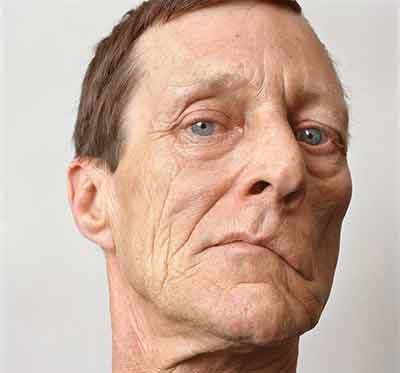
The stroke prevented the use of the facial muscles on his left side. See how the left side of his face changed? It literally drooped down. This is because the normal stimulus that existed on the bones just disappeared.
The reason this change was so drastic is that the stimulus was constant. If you could find a way to mew 24/7, even in your sleep, your bones would change just as fast.
Lou Gehrig’s Disease
Lou Gehrig’s disease, or ALS, consists of the progressive degeneration of motor neurons.
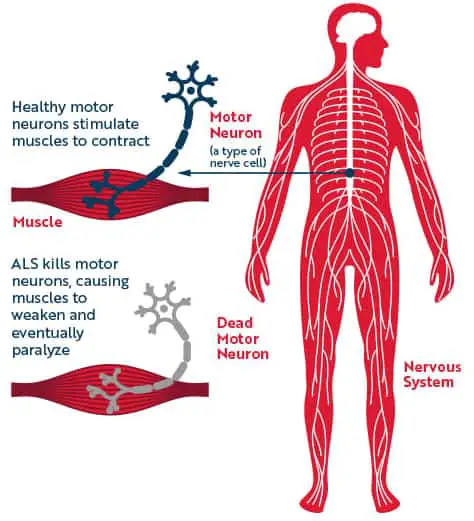
Over time, the victim becomes unable to move his muscles. This is what afflicted scientist Stephen Hawking:

As you can see, he started average-looking. But as the normal stimulus on his muscles began to disappear, this began to have a warping effect on his skeleton over time. His bite and entire skeleton changed for the worse.
Muscular Dystrophy
Muscular dystrophy is a similar disease that prevents movement in the facial muscles.
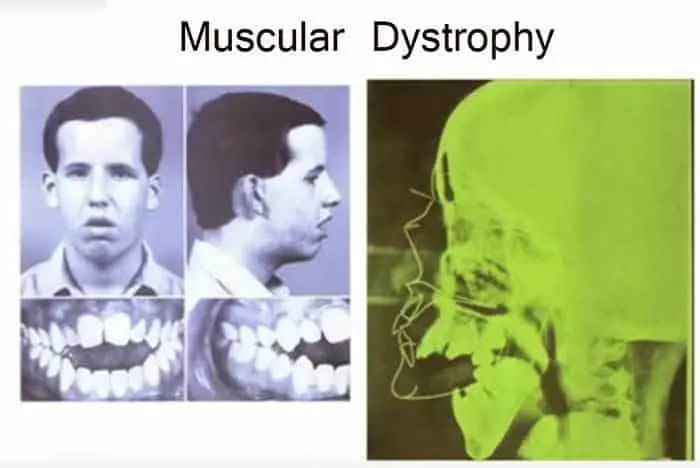
Normal Aging Process
You don’t have to have a crippling disease for your bones to change for the worse. It happens naturally anyway with the normal aging process (Eduardo et al, 2017):
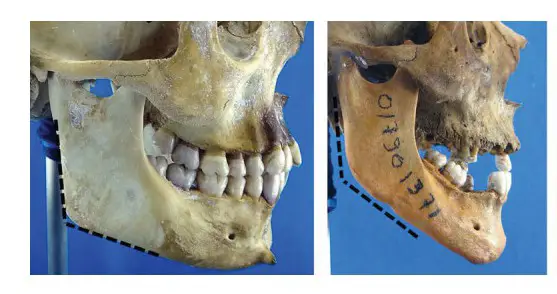
Note the decreased gonial angle. This is a normal result of the maxillary recession with aging. It happens normally. But you can actually get this process to move in the other direction by working on your posture.
Health Benefits
Mewing confers several health benefits that start to take hold within weeks or months.
Sleep Apnea
By mewing, you are creating more space for your tongue and jaw, as well as constantly keeping it in the right position. This is going to be the number one thing you can do to help prevent sleep apnea. The source of sleep apnea is a lack of tongue space.
Nose Breathing
The average person breathes 17000 times per day or 6 million times per year. By keeping your teeth together and tongue on the roof of your mouth, you will learn to constantly breathe through your nose. This can happen in as fast as several weeks.
Humans are meant to breathe through our nose. It provides 50% more resistance to airflow than breathing through your lungs. But the nose helps humidity and filter air. It removes particulates as small as 0.5 microns (Schwab et al, 1998).
Your breathing will adapt to be much deeper and slower when breathing through your nose. Mouth breathing is meant for stressful situations that require extra oxygen. Doing it during the day or when you’re sleeping can subtly increase your stress levels. The negative effects of chronic stress has been well documented. It’s a risk factor for almost every disease.
Submental Area Improvements
You don’t have to have bone changes to have an improved appearance from mewing. One of the first things to change is the submental region, the area under the jawline. This is because raising the tongue also moves all the tissue under the tongue. Your hyoid bone is connected to the base of your tongue as well as all the muscles that are under your jaw.
Here are some examples of submental area improvements:
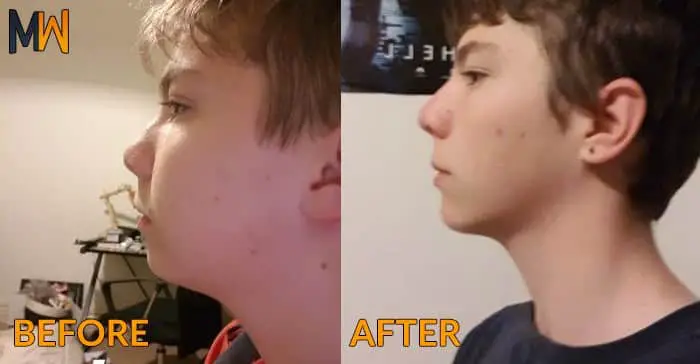
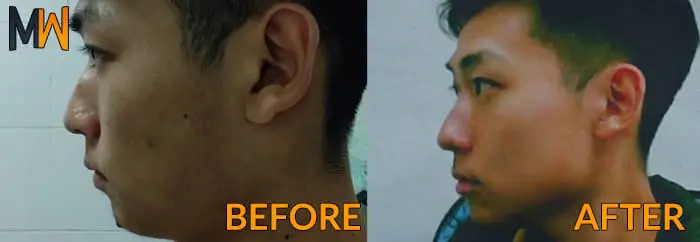
As you can see, their jawline became more prominent just from this postural change. Once you mew long enough, the muscle tension built up in your tongue will make it so that your new posture is your normal posture.
Relevant Studies
Mewing is difficult to study in a controlled environment. Most of the research being done is the work of one man at this point (Dr. Mike Mew). But more funding and interest is needed before a true study comes out showing that mewing works for adults. However, there’s some promising work that has been done already:
Primate experiments on oral respiration
This 1981 study by Harvold et al. in the American Journal of Orthodontics plugged the noses of rhesus monkeys and observed them over 3 years. The monkeys were 2 to 6 years old and were arranged in pairs based on age, sex, and similar facial morphology. One of the monkeys served as a control and was left alone, and the other had its nose plugged. The effects of mouth breathing over 3 years were later observed.
The findings in the mouth breathing monkey group were as follows:
Lips: They developed a notch in the upper lip, corresponding to lip activity in the lip elevator muscle.
Tongue: The dorsal section of the tongue became thinner, opening a passage to the pharynx. Other changes in tongue morphology were noted.
Dentition: Narrowing of the mandibular dental arch. A decrease in maxillary arch length. Development of an incisor cross-bite.
Bite Movement: There was a dual bite and some animals could not keep their teeth together.
Cephalometric Measurements: increased face height, steeper mandibular plane, and larger gonial angle.
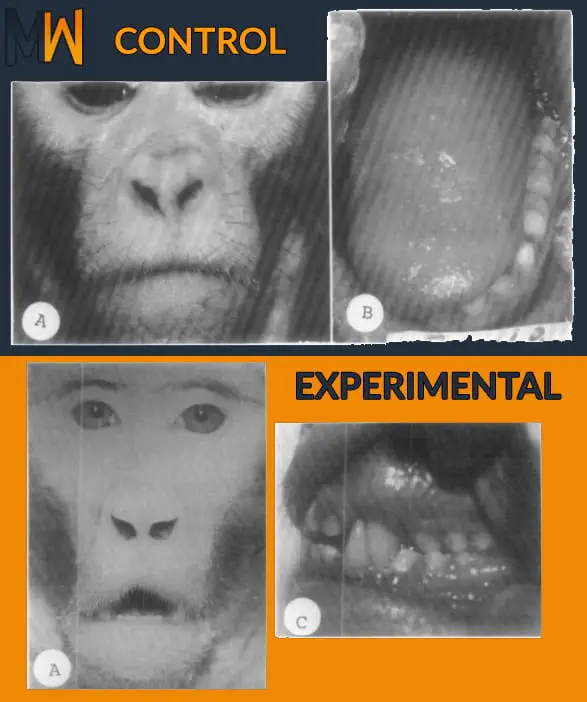
The researchers concluded that “it can be postulated that increased tonic activity in certain muscles and a specific change in jaw positioning may cause corresponding bone remodeling, which should be predictable”.
We may assume that the human being is as resourceful as the monkey when forced to establish an oral airway. The human mouth breather may also present a variety of symptoms, ranging from normal appearance to severe skeletal and dental irregularities. Nasal obstruction presents the trigger factor, but it is the deviant muscle recruitment which causes maldevelopment.
Facial Changes Following Treatment With a Removable Orthodontic Appliance in Adults
This 2004 study by Singh et al. looked at the Homeoblock, which is a removable orthodontic appliance. From the Homeoblock website:
Activated by swallowing, the signal mechanism exerts intermittent light force on the teeth, eliciting a bone cell response that changes the shape of craniofacial bones over time. Tension and intermittent light force persuade the bones to redefine themselves, resulting in enhanced facial symmetry, regardless of age.
The study found:
- The maxillary arch had a 30% size increase
- A 10% size increased of the maxilla
- The canthal tilt of the eyes had improved.
It is concluded that dental and facial changes associated with the Homeoblock’ removable orthodontic appliance are consistent with a broader smile and a more symmetrical facial appearance in non-growing adults.
Treatment and retention of relapsed anterior open-bite with low tongue posture and tongue-tie: A 10-year follow-up
This 2014 study by Yu-Jin Seo et al. took a look at a 19-year-old who had class 3 malocclusion, an open bite, difficulty chewing food, receded chin, and incompetent lips.
Treatment consisted of this device being placed in his mouth, which served two purposes:
1) Keep the tongue on the roof of the mouth.
2) Push downwards on the appliance, to fix the lower teeth.
Here is a picture of his teeth before and after treatment:

The researchers also concluded “Collectively, the results contributed to an improvement in lip competency and facial profile.”
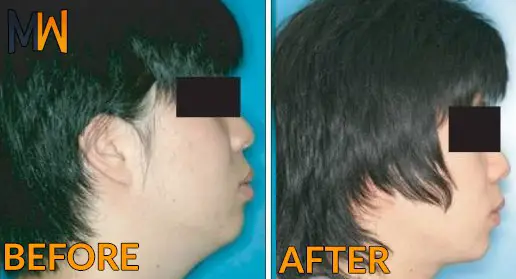
However, the bite results speak for themselves and the fact that he didn’t relapse after several years, unlike with orthodontic treatments, is a feat in itself.
Examples Of Mewing For Adults
Here are some examples of before/after photos of adults who have seen results with mewing. The changes can be subtle so if you don’t know what to look for, see our article which explains the differences.
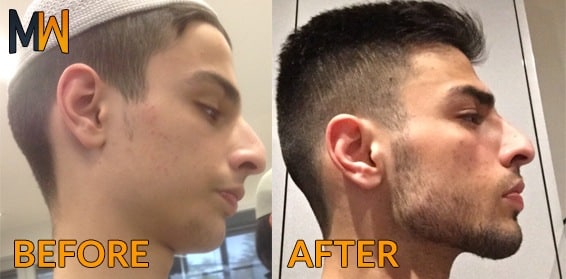
Source: Imgur
Final Age: 17
Time: 1.5 yrs

Source: BreaktheMatrix
Final Age: 19
Time: 18 months
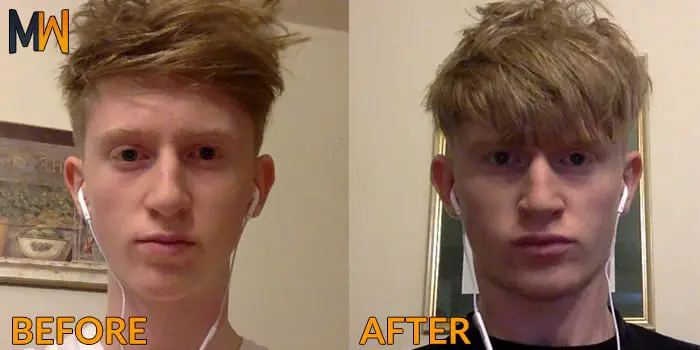
Source: Reddit
Final Age: 20
Time: 3 years
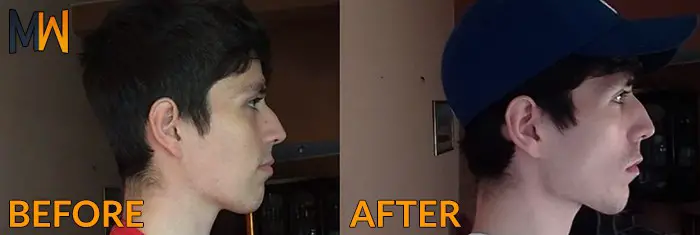
Source: Reddit
Final Age: 22
Time: 1.5 years
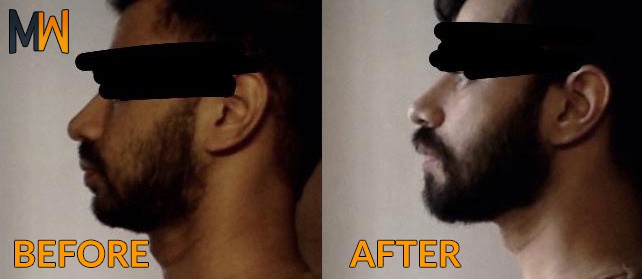
Source: Reddit
Final Age: 29
Time: 1 year
Click here for more mewing before/after photos.
Get Started Now
Regardless of how fast bone changes take place, you should begin mewing regardless. Even if it’s just for the health benefits alone, it’s still worth it. The transition to nose-breathing, prevention of sleep apnea, and the improved utilization of oxygen means you should be doing this no matter what.
It’s never too late. Mike Mew himself only started mewing in his 30s, and look at his jaw now.
It takes up none of your time because it’s simply proper posture. Just do what you would be doing anyway, only pay attention to your posture. For a full break down of how to mew properly, visit our Ultimate Mewing Guide.

